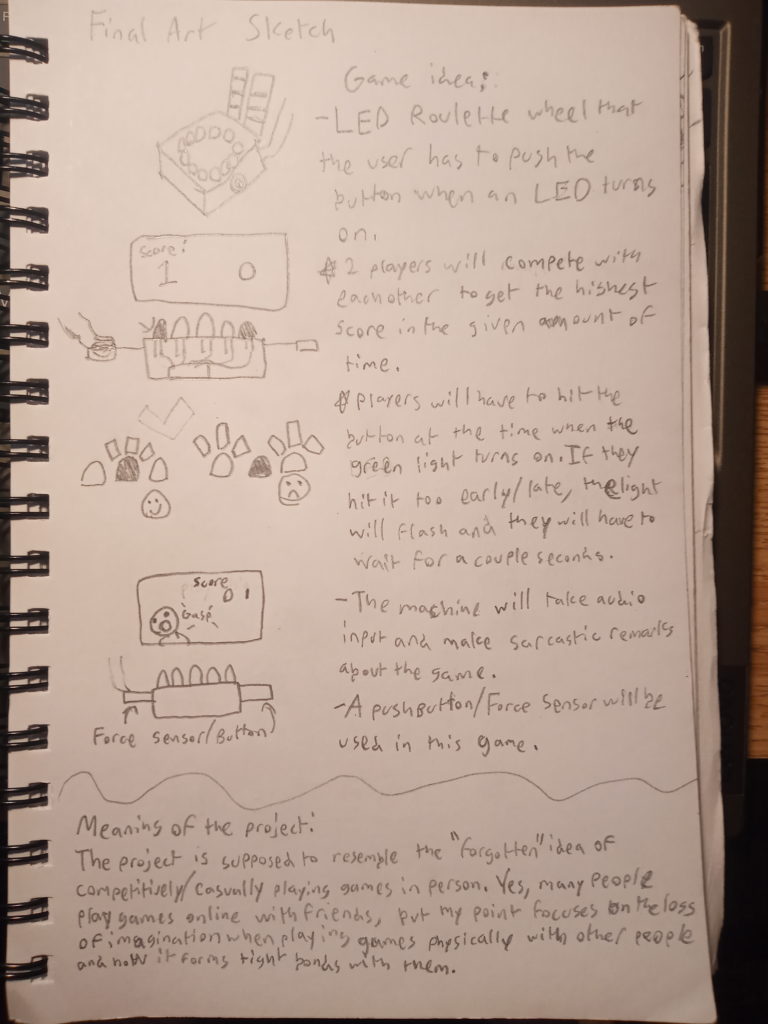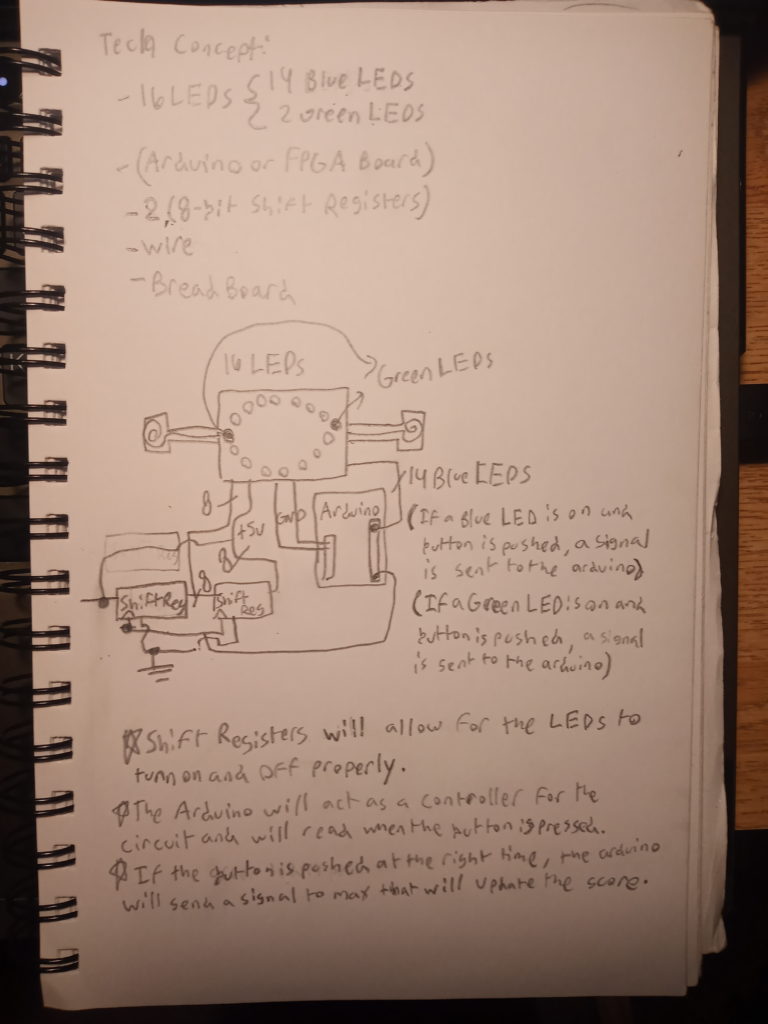The final project that I will be making revolves around the idea of a roulette-like game. The object of the game is to score higher than your opponent. The way to get points in the game is to try and hit the force sensor/button at the same time as when the different colored LED comes on. Once this occurs, the screen will auto adjust the score and play some sarcastic audio/video. The whole symbolism of the project is to try and recreate the physical atmosphere of playing physical games with a friend/family member. With online video stream/games becoming more common in the daily life of everyone, I feel that the bonds over playing board games and telling stories has been somewhat lost. I want to try and recreate that enjoyable atmosphere with a simple game. Below is an image showcasing the overall design of the project.

There are two ways that I would be able to accomplish this goal. One way is with using the Arduino that we had used for class. The only issues with using the Arduino is that there wouldn’t be enough outputs for the LEDS to allow me to code them in. Instead, I would have to use a shift register, which is a component that would allow me to control all 16 LEDs. I would have to research the component and figure out a way to hook it up, without it obstructing the area around the breadboard (I tend to use a lot of wire when creating circuits). My plan is to find a datasheet for the component and to see if the ECE store has supply for the component. Overall, this path would be very simple to do and I could program it directly into Arduino and Max. Below is an image of the written tech demo that I have that showcases the circuit.

The other way I could approach this project is by using a FPGA board that I have. The board that I currently have has enough outputs to satisfy what I need. This also means that I wouldn’t need any external components, such as the shift register. The only issue is that it isn’t compatible with the Arduino software, meaning that I would have to use a different application and learn how to sync it to Max. My plan for research is to experiment with the different connections of the board and to see if I could be able to sync the board with one of the inputs of the FPGA. The board is also rather large, making the overall result of the box larger than one would hope for such a small game.
I hope that I can confine the breadboard and the programmable board into a small box with LEDs poking out at the top. The sides are also where there will be a button that will be controlled by the players. The connectors will appear out a small hole at the end of the box (somewhat invisible to the overall aesthetic of the box). I want the whole circle to be consisted of 14 blue LEDs, with 2 green LEDs to indicate when the LED that the players want to pay attention to. I would need to use resistors, as to limit the current going into the LEDs. The LEDs and Arduino will plug into the laptop and the Max patch will be playing the score on-screen.
Artist Question: I would like to try and make the box aesthetically pleasing. Should I try to 3D print the box, or should I use carboard or wood?
I think using wood would resemble the feeling of playing with a board game and really pushes that concept you were aiming for. The wood/old-fashioned style board contrasts with the modern LED and tech, which is also a neat aspect of using wood.
I do agree with your comment and think that the texture of the wood would look good with the overall design. The only issue I see in using wood is that I would need to learn how to use the laser cutter in Innovation Studio.
I think cardboard is the most accessible and least risk-prone/dependent if something goes awry.
I do agree with the use of cardboard, another bonus being that it is not that expensive(free most of the time). However, my craftsmanship is something that I feel would hinder the quality of the project.
I like the idea of the narrator being sarcastic. I sort of feel a sense of Battleblock Theatre for this project and I can’t wait to see this in action.
I like that video game comparison. I do feel that the sarcasm would add a sense of character to the game.
To answer your question, I feel like a box would not only be easier to access than 3D printing, but also more moldable and versatile for your purposes. Otherwise, this is an impressively advanced idea for a project, and I’m very curious to see how you implement such a project.
I do agree that making a box out of wood and cardboard would be more versatile and moldable, but I am worried about my usage of glue (due to how I seem to use a ton of it when I think I am not). I feel that the glue may make the overall presentation less professional.
If you decide to go with the FPGA board, it should be quite simple to get it talking to Max. The serial communication protocol is very universal and can be used between any type of digital hardware.
That is good to know. Thank you for the information. The major reason I will probably use the Arduino, over the FPGA, is because of how compact the design is. It is much easier to fit in the box that I have, than the FPGA. However, I may use the FPGA if the code for the Arduino gets too complicated.